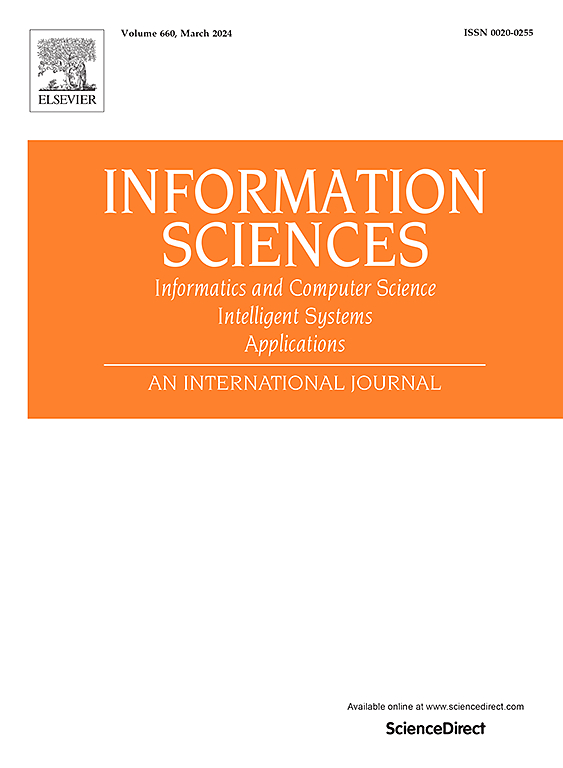面向自解释审查垃圾邮件组检测
IF 8.1
1区 计算机科学
0 COMPUTER SCIENCE, INFORMATION SYSTEMS
引用次数: 0
摘要
由于数据不平衡,现有的垃圾邮件发送者组检测方法往往产生不理想的性能。此外,这些方法中的许多都像黑盒子一样运作,对其检测结果几乎没有可解释性。为了解决这些问题,我们提出了一种自解释的方法来检测评论垃圾邮件发送者组。我们的方法首先构造一个具有边属性的用户-积二部图。我们将用户评论信息与一种新的适应度函数相结合,开发了一种自适应遗传算法,有效地识别出高质量的候选群体。接下来,我们引入了一个带有主动学习增强的混合图神经网络来生成这些候选组的向量表示。然后,我们设计并构建了一个原型层和一个组分类层来准确地检测垃圾邮件发送者组。为了提供可解释性,我们结合原型学习来创建解释检测结果的解释机制。实验结果表明,我们的方法在排名前1000位的Precision@k和Recall@k上取得了显著的改进,分别比Amazon、YelpChi、YelpNYC和YelpZip数据集上的最先进解决方案提高了[11.53%、97.36%、51.37%、32.06%]和[12.65%、54.65%、64.19%、47.37%]。此外,在不同稀疏度水平下,我们的可解释性结果的保真度比相同数据集上现有方法的保真度分别高出约4%、9%、8%和8%。本文章由计算机程序翻译,如有差异,请以英文原文为准。
Towards self-interpretable review spammer group detection
Due to data imbalance, existing spammer group detection methods often yield suboptimal performance. Moreover, many of these approaches operate as black boxes, offering little to no interpretability for their detection results. To address these issues, we propose a self-interpretable approach for detecting review spammer groups. Our method begins by constructing a user-product bipartite graph with edge attributes. We integrate user review information with a novel fitness function to develop an adaptive genetic algorithm that effectively identifies high-quality candidate groups. Next, we introduce a hybrid graph neural network enhanced with active learning to generate vector representations of these candidate groups. We then design and construct a prototype layer and a group classification layer to detect spammer groups accurately. To provide interpretability, we incorporate prototype learning to create an interpretation mechanism that explains detection outcomes. Experimental results demonstrate that our method achieves substantial improvements in Precision@k and Recall@k at the top-1000 ranking, outperforming state-of-the-art solutions on the Amazon, YelpChi, YelpNYC, and YelpZip datasets by [11.53 %, 97.36 %, 51.37 %, 32.06 %] and [12.65 %, 54.65 %, 64.19 %, 47.37 %], respectively. Additionally, the Fidelity of our interpretability results under varying Sparsity levels is approximately 4 %, 9 %, 8 %, and 8 % higher than those of existing methods on the same datasets.
求助全文
通过发布文献求助,成功后即可免费获取论文全文。
去求助
来源期刊

Information Sciences
工程技术-计算机:信息系统
CiteScore
14.00
自引率
17.30%
发文量
1322
审稿时长
10.4 months
期刊介绍:
Informatics and Computer Science Intelligent Systems Applications is an esteemed international journal that focuses on publishing original and creative research findings in the field of information sciences. We also feature a limited number of timely tutorial and surveying contributions.
Our journal aims to cater to a diverse audience, including researchers, developers, managers, strategic planners, graduate students, and anyone interested in staying up-to-date with cutting-edge research in information science, knowledge engineering, and intelligent systems. While readers are expected to share a common interest in information science, they come from varying backgrounds such as engineering, mathematics, statistics, physics, computer science, cell biology, molecular biology, management science, cognitive science, neurobiology, behavioral sciences, and biochemistry.
 求助内容:
求助内容: 应助结果提醒方式:
应助结果提醒方式:


